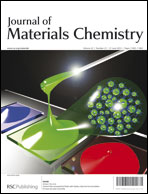The structural, microstructural, electrical and magnetic characterization of microcrystalline powders of new Ti manganites Sr2−xBixMnTiO6 (0 ≤ x ≤ 0.75) is reported. Compositional characterization by means of EDS and XPS confirms the stoichiometry of all samples to be practically equal to the nominal ones. Neutron and X-ray diffraction data show that all the samples crystallize with cubic symmetry, space group Pm![[3 with combining macron]](https://www.rsc.org/images/entities/char_0033_0304.gif) m, which is broken at the nanoscale as Raman spectroscopy and HRTEM/ED analysis suggest. The complex magnetic response is interpreted by considering the magnetic frustration derived from the presence of structural and atomic disorder; initial AFM behavior evolves to FM predominant interactions as x increases and superparamagnetic clusters stabilize above Tc. The variation of the permittivity with temperature for x ≥ 0.50, obtained from impedance measurements, seems to be related to a relaxor-type ferroelectric behaviour. The title materials could be regarded as a potential local multiferroic system, given that both the FE and FM responses seem to be dependent on the formation and development of BiMO3-type clusters, and therefore they are correlated.
m, which is broken at the nanoscale as Raman spectroscopy and HRTEM/ED analysis suggest. The complex magnetic response is interpreted by considering the magnetic frustration derived from the presence of structural and atomic disorder; initial AFM behavior evolves to FM predominant interactions as x increases and superparamagnetic clusters stabilize above Tc. The variation of the permittivity with temperature for x ≥ 0.50, obtained from impedance measurements, seems to be related to a relaxor-type ferroelectric behaviour. The title materials could be regarded as a potential local multiferroic system, given that both the FE and FM responses seem to be dependent on the formation and development of BiMO3-type clusters, and therefore they are correlated.

You have access to this article
 Please wait while we load your content...
Something went wrong. Try again?
Please wait while we load your content...
Something went wrong. Try again?
![[3 with combining macron]](https://www.rsc.org/images/entities/char_0033_0304.gif) m, which is broken at the nanoscale as
m, which is broken at the nanoscale as 

 Please wait while we load your content...
Please wait while we load your content...